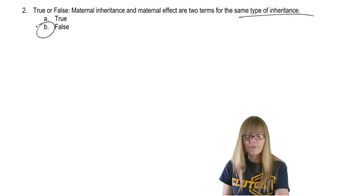The gene controlling the Xg blood group alleles (Xg⁺ and Xg⁻) and the gene controlling a newly described form of inherited recessive muscle weakness called episodic muscle weakness (EMWX) (Ryan et al., 1999) are closely linked on the X chromosome in humans at position Xp22.3 (the tip of the short arm). A male with EMWX who is Xg⁻ marries a woman who is Xg⁺ and they have eight daughters and one son, all of whom are normal for muscle function, the male being Xg⁺ and all the daughters being heterozygous at both the EMWX and Xg loci. Following is a table that lists three of the daughters with the phenotypes of their husbands and children. Create a pedigree that represents all data stated above and in the following table.
Table of contents
- 1. Introduction to Genetics51m
- 2. Mendel's Laws of Inheritance3h 37m
- 3. Extensions to Mendelian Inheritance2h 41m
- 4. Genetic Mapping and Linkage2h 28m
- 5. Genetics of Bacteria and Viruses1h 21m
- 6. Chromosomal Variation1h 48m
- 7. DNA and Chromosome Structure56m
- 8. DNA Replication1h 10m
- 9. Mitosis and Meiosis1h 34m
- 10. Transcription1h 0m
- 11. Translation58m
- 12. Gene Regulation in Prokaryotes1h 19m
- 13. Gene Regulation in Eukaryotes44m
- 14. Genetic Control of Development44m
- 15. Genomes and Genomics1h 50m
- 16. Transposable Elements47m
- 17. Mutation, Repair, and Recombination1h 6m
- 18. Molecular Genetic Tools19m
- 19. Cancer Genetics29m
- 20. Quantitative Genetics1h 26m
- 21. Population Genetics50m
- 22. Evolutionary Genetics29m
2. Mendel's Laws of Inheritance
Pedigrees
Problem 38c
Textbook Question
Draw a pedigree containing two parents and four children. Both of the parents have AB blood type. The first child is type A, the second child is type AB, and the third child is type B.
What is the name of the genetic phenomenon producing this observation?
 Verified step by step guidance
Verified step by step guidance1
Start by understanding the genetic basis of ABO blood types. The ABO blood group system is determined by a single gene (I) with three alleles: IA, IB, and i. IA and IB are codominant, meaning both are expressed when present together, while i is recessive.
Draw the pedigree chart. Represent the two parents at the top of the chart. Both parents have AB blood type, which means their genotypes are IAIB. Connect them with a horizontal line to indicate they are a couple.
Add four children below the parents, connected by vertical lines. Label the first child as blood type A, the second child as blood type AB, and the third child as blood type B. Leave the fourth child unassigned for now, as it is not mentioned in the problem.
Determine the possible genotypes of the children based on the parents' genotypes (IAIB). Use a Punnett square to calculate the probabilities of inheritance. The possible combinations are: IAIA (type A), IAIB (type AB), IBIB (type B), and IAi or IBi (type A or B, respectively). The observed blood types match these possibilities.
Explain the genetic phenomenon observed. The phenomenon is codominance, where both IA and IB alleles are expressed equally in individuals with the AB blood type. This explains why the second child has AB blood type and why the other children exhibit either A or B blood types depending on the inherited alleles.
 Verified video answer for a similar problem:
Verified video answer for a similar problem:This video solution was recommended by our tutors as helpful for the problem above
Video duration:
1mPlay a video:
Was this helpful?
Key Concepts
Here are the essential concepts you must grasp in order to answer the question correctly.
Blood Type Inheritance
Blood type is determined by the ABO gene, which has three alleles: A, B, and O. Each person inherits one allele from each parent, resulting in four possible blood types: A, B, AB, and O. In this case, both parents with AB blood type can pass on either A or B alleles, leading to the observed blood types in their children.
Recommended video:
Guided course

Types of Maternal Inheritance
Codominance
Codominance is a genetic phenomenon where both alleles in a heterozygous individual are fully expressed, resulting in a phenotype that displays characteristics of both alleles. In the context of blood types, the AB blood type exemplifies codominance, as both A and B antigens are present on the red blood cells.
Recommended video:
Guided course

Variations on Dominance
Punnett Square
A Punnett square is a diagram used to predict the genetic outcomes of a cross between two individuals. By mapping the possible allele combinations from each parent, it helps visualize the probability of offspring inheriting specific traits, such as blood types in this scenario, aiding in understanding the inheritance patterns.
Recommended video:
Guided course

Chi Square Analysis
Related Videos
Related Practice
Textbook Question
954
views


